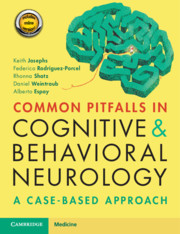Book contents
- Common Pitfalls in Cognitive and Behavioral Neurology
- Common Pitfalls in Cognitive and Behavioral Neurology
- Copyright page
- Dedication
- Contents
- Diseases Discussed in the Book
- Preface
- Acknowledgements
- Abbreviations
- Part 1 Missing the Diagnosis Altogether
- Part 2 Misidentifying the Impaired Cognitive Domain
- Part 3 Missing Important Clues in the History
- Part 4 Failure of Pattern Recognition
- Part 5 Difficult-to-Characterize Cognitive/Behavioral Disorders
- Part 6 Clinical Findings That Are Subtle
- Case 26 Something Does Not Look Right
- Case 27 Moving without Thinking
- Case 28 A Pause in the Clause
- Case 29 Seeing beyond Alzheimer Disease
- Case 30 “That Is Not How I Feel”
- Part 7 Misinterpreting Test Results
- Part 8 Attributing Findings to a Known or Suspected Disorder
- Part 9 Missing Radiographic Clues
- Part 10 Management Misadventures
- Index
- Plate Section (PDF Only)
- References
Case 30 - “That Is Not How I Feel”
from Part 6 - Clinical Findings That Are Subtle
Published online by Cambridge University Press: 03 November 2020
- Common Pitfalls in Cognitive and Behavioral Neurology
- Common Pitfalls in Cognitive and Behavioral Neurology
- Copyright page
- Dedication
- Contents
- Diseases Discussed in the Book
- Preface
- Acknowledgements
- Abbreviations
- Part 1 Missing the Diagnosis Altogether
- Part 2 Misidentifying the Impaired Cognitive Domain
- Part 3 Missing Important Clues in the History
- Part 4 Failure of Pattern Recognition
- Part 5 Difficult-to-Characterize Cognitive/Behavioral Disorders
- Part 6 Clinical Findings That Are Subtle
- Case 26 Something Does Not Look Right
- Case 27 Moving without Thinking
- Case 28 A Pause in the Clause
- Case 29 Seeing beyond Alzheimer Disease
- Case 30 “That Is Not How I Feel”
- Part 7 Misinterpreting Test Results
- Part 8 Attributing Findings to a Known or Suspected Disorder
- Part 9 Missing Radiographic Clues
- Part 10 Management Misadventures
- Index
- Plate Section (PDF Only)
- References
Summary
This 52-year-old left-handed woman with a 10-year history of multiple sclerosis (MS) developed fluctuating affect over the last year. Her children described she cried or laughed inappropriately, without a clear trigger. These episodes lasted less than 10 minutes. Even in the occasions where there was an emotion-triggering event, the response (crying or laughing) was disproportionate and contrary to the expectations (i.e., laughing at something sad). These episodes of laughter and crying were beyond her control and lasted a couple of minutes. Although the patient endorsed being frustrated about these episodes, and endorsed fatigue and slowness in her thinking, she denied persistence in feeling sad, lacking interests or thinking about death. On exam, she exhibited a spastic-ataxic speech and generalized ataxia with spasticity in her upper extremities. Her Beck Depression Inventory (BDI) score was 11, meeting threshold for mild mood disturbance (discouraged about the future, not enjoying things, feeling disappointed about her life, crying more, being more irritable, taking longer to make decisions, being concerned about her looks, needing extra effort to do things, difficulties sleeping, and being worried about her health).
- Type
- Chapter
- Information
- Common Pitfalls in Cognitive and Behavioral NeurologyA Case-Based Approach, pp. 96 - 98Publisher: Cambridge University PressPrint publication year: 2020



